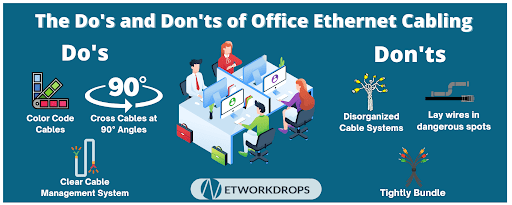Installing an ethernet cable properly can be a tricky thing at times. While some might think that installing network wiring is the same as running any other type of cable, the truth is data cabling is a lot more sensitive, and improper installation can create a variety of network issues. With ethernet cable becoming increasingly integrated into our world of evolving technologies, understanding how to install it right can be the difference between an efficient network and a troubled one.
As one of the leading installers of Cat6 cable wiring in New Jersey, the Network Drops team understands what it takes to create a fast and effective network. We have the experience laying out the ethernet cables that give your office the means to succeed in the modern business world. Our team can help you plan out and design the most efficient cable layout to make the most of your space. We’ll cover a comprehensive list of the do’s and don’ts of ethernet cabling, which you will find below:
Do: Cross Power Cables at a 90º Angle.
One common mistake when running network wires is running the ethernet cable parallel to power cables. Anything that carries an electrical current or signal can create EMF interference in network cables that are not shielded. To minimize this interference, cross power cables as little as possible and do so at a 90º angle for the least disturbance.
Don’t: Run the Cable in Unsafe Locations.
Running the cable through the ceiling or a wall is often unavoidable. When this situation happens, be sure never to touch the ceiling tiles and avoid running the cable over electrical conduit or pipes. The potential for burst pipes and water leaks can cause havoc on your infrastructure. Additionally, laying out the wires in these locations can lead to failed inspections.
Do: Use Separate Color Schemes.
Staying organized is always a smart idea when wiring a network. Use colors to coordinate and distinguish your data lines to keep track of the wires. If you upgrade your system in the future, the color-coded wires help streamline that process and take much of the guesswork out of it for future installers.
Don’t: Bundle Cables Tightly.
You might think that tightly bundling your cables can help reduce the amount of space they take up. However, that rarely is the case. Tightly bundled cables can kink, having a negative effect on your network and reducing the quality of the cables themselves. Cables that are bound tightly can also present challenges when attempting to troubleshoot network problems.
Do: Use a Wire Management System
While tightly bundling your cables is a no-go, that doesn’t mean that you can’t utilize proper wire organization practices. Using a safe and effective wire bundling product like cable ties or even Velcro® can help you stay organized between racks. You can also create a simple map that lays out the cable locations for a quick and easy guide for future repairs and replacements.
Finding the right team to help you map out your next ethernet cable structure can prove nerve-wracking. The wrong choice can put your future productivity at a severe disadvantage in the future. If your business needs a fast, reliable, and secure network, contact the leading Cat6 installers in New Jersey at Network Drops and get a quote today!

